It was in the spring of 2003 that I first met Pascal Madevon.
The former winemaker at Château La Tour Blanche in St. Christoly du Médoc, looked horribly uncomfortable as a gaggle of wine journalists were flown in to the Okanagan to witness for the first time a joint venture wine project between Vincor (back then a wholly owned Canadian company) and Groupe Taillan from Bordeaux.
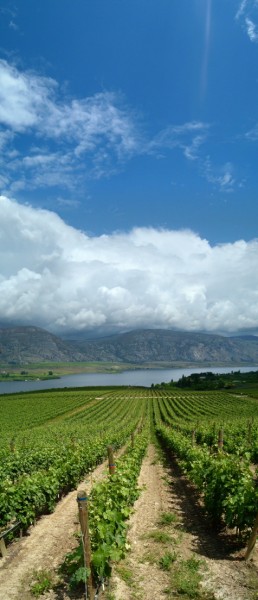
We were brought to an industrial warehouse in the south Okanagan town of Oliver, B.C. (which now houses Vincor’s main tasting room and retail store but was just a wine making facility and office complex in 2003) to taste this new wine, called Osoyoos Larose, and meet the man who was hired to produce it.
Osoyoos Larose was the western bookend to another Vincor project undertaken in Niagara, called Le Clos Jordanne. Le Clos is a Burgundian inspired brand making only Pinot Noir and Chardonnay of the highest quality. Osoyoos was the Bordeaux-inspired project that Vincor wanted in its stable. One wine, the best that could be made, from a combination of the five red varieties allowed under Bordeaux law — Cabernet Sauvignon, Cabernet Franc, Merlot, Malbec and Petit Verdot.
Our tasting samples were spread out on top of barrels in the warehouse while Donald Triggs, then CEO of Vincor, introduced Madevon to the curious crowd of wine scribes.
“Osoyoos†refers to the location of the vineyards overlooking Osoyoos Lake in the southernmost part of the Okanagan Valley, located at 49oN latitude, just north of the U.S. border. “Larose†refers to Château Gruaud-Larose, one of a number of estate wineries owned by Groupe Taillan in Bordeaux. Located in St-Julien, one of the top winemaking communities in Médoc, this château carries the highly revered, second growth ranking within the quality and pricing classification system that was established for Bordeaux wines in 1855.
Vincor and Taillan believe that by employing the centuries-old winemaking traditions of France with New World state-of-the- art equipment and technology they could create outstanding wines with the classic Bordeaux varietals in the southern part of the Okanagan.
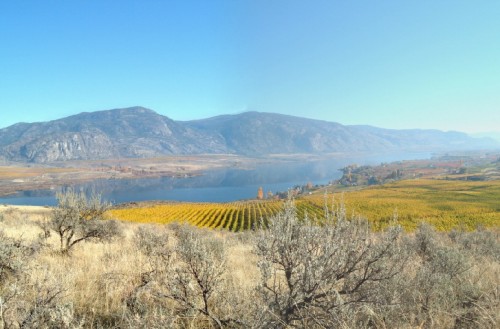
The Osoyoos Larose partners invested significant resources in the development of four vineyard blocks, covering 32 hectares. Planting occurred in 1999 (9.75 ha), 2000 (7.75 ha), 2001 (6.75 ha) and 2006 (7.75 ha). On these arid hillside vineyard sites above Osoyoos Lake, Madevon does his most important work. He diligently tends the vines through each season to yield superior fruit. Madevon has a unique growing strategy for each plant, which he believes plays an integral role in defining the quality of fruit he will receive at harvest.
Considerable attention was also spent on the winemaking process, which takes place in a modern wine-making cellar in Oliver. The very best equipment from France was installed. Since its inception, the winery has purchased more than 300 oak barrels annually sourced from eight noted coopers in central France.
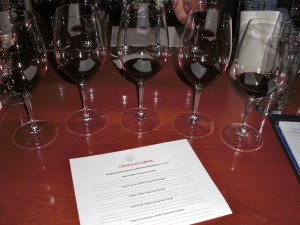
The inaugural wine, Osoyoos Larose Le Grand Vin 2001, was launched at a series of events in the United States, Canada and Europe in April of 2004.
Our tasting was the first organized event to see first hand what all the fuss was about.
I remember listening to Madevon talk about the new wine, but not really understanding through his thick French accent at the time. When it came time to taste the wine, it was something I will never forget.
The blend was the only one made with just three varieties — 66% Merlot, 25% Cabernet Sauvignon and 9% Cabernet Franc.
But on the very first sip it was totally and staggeringly unapproachable as a drinkable wine. It was bigger than any other wine being made in Canada, with aggressive tannins, oak saturation and dark, thick fruits that felt gritty on the palate and stained our teeth with just a few sips.
The writers looked at each other with curious shrugs and talked long and hard into the wee hours about how such a stern wine could be made commercially and sold to consumers.
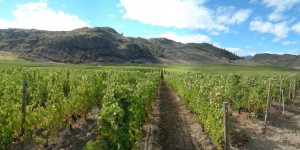
The reviews for the debut wine were mixed — some loving the severe Bordeaux style and others wondering if the wine would ever show well in the glass. It was something that had never been attempted in Canadian red wine making.
Since the release of the 2001 debut vintage, subsequent vintages have received strong reviews. Now, with the experience of seven harvests in the Okanagan Valley, Madevon feels he truly understands the unique terroir of the site and that he has captured the essence of the Osoyoos Larose vineyards in his wines.
I travelled back to the Okanagan Valley yearly for a while and always made sure I touched base with the development of Osoyoos Larose and was pleased to find the wine softening and becoming more balanced and approachable. I don’t believe I was ever “in love” with that first wine but have found Madevon’s style to be shifting towards a friendlier style with each passing vintage.
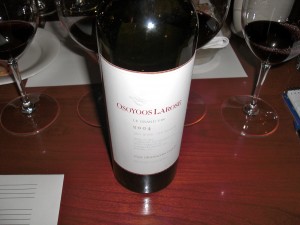
I recently had the pleasure of tasting four vintages of Osoyoos with Madevon over a big juicy ribeye steak at Spencer’s On the Water in Burlington. He brought the current 2006 vintage (at Vintages now) to taste alongside the new 2007 vintage, 2005 and 2004.
It was fascinating to taste these wines side by side and experience where this wine is headed (which is the right direction, by the way).
Although it was hard to hear a word Medevon said at the dinner, which was in a noisy section of the restaurant, and the two or three wine writers in attendance had to compete with the very attentive Susanne and Georgia, aka The Wine Ladies (check it out here) the wines really did speak for themselves.
We were first offered up a taste of the unfinished components of the 2009 Osoyoos Larose to see what each brings to the final blend.
The Merlot was all smoky cassis, blackberry and spice, the Cabernet Franc brought anise, bell pepper and plush tannins, the Petit Verdot chimed in with even bigger tannins and lovely aromatics while the Malbec offered cherry and more backbone tannins and, finally, Cabernet Sauvignon formed the basis of the fruit on the palate — blackberry, cherry, herbs and spice.
The final blend is somewhat determined by the vineyard, but generally it’s dominated by Cab Sauv, Merlot and Cab Franc with tiny amounts of Malbec and Petit Verdot.
Osoyoos Larose winemaking:
When the grapes arrive at the winery doors they are carefully transferred into a new destemmer/crusher machine made in France by Amos. The juice, skins and seeds (known as “mustâ€) are then moved into one or more of the 10 unique, cone- shaped fermentation tanks in the principal tank room, where they form a “cap†over the grape juice. Each grape variety is fermented separately, and the same yeast is used for the entire crop.
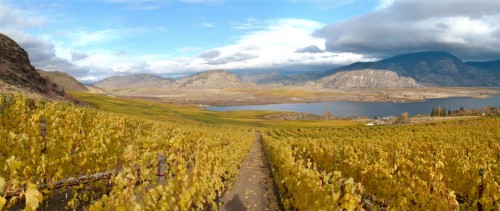
The fermentation tanks were custom-designed by Alain Sutre in conjunction with the French manufacturer, Guérin, and were shipped to the Okanagan Valley and assembled in place by the French manufacturing team. Of the 10 tanks, 4 have a capacity of 8,700 litres (2300 US gals.), another 4 have a capacity of 13,500 litres (3,570 US gals.); and 2 have a capacity of 17,600 litres (4650 US gals.).
The tanks are unique in the fact that their height (approximately 3 metres) is the same as their diameter, which creates an optimum size for the exchange surface between the must and the cap of the grape skins and increases the richness of the wine in the skin components. The shape of the tanks is ideal for limiting temperature fluctuations in the must, and reduces problems with the yeast. “Pigeage†(the punching down of the cap) is also easier because of the shorter tank height and the wider punching surface.
During fermentation, Italian-made Francesca pumps assist the “remontage†or “pumping over,†by gently circulating the liquid inside the tank and promoting and controlling aeration. This happens more frequently towards the end of the fermentation process. The fermentation temperature is kept between 28° and 33°C and the process takes between 10 to 15 days.
After fermentation, the cap is pressed in a French Bucher XPF 80 pneumatic press and stored separately. The “free run†wine from the tanks is transferred slowly into oak barrels for aging over approximately 16 months. Osoyoos Larose has purchased oak barrels made from trees from the various forests of central France. Placing emphasis on the craftsmanship of the French barrel makers, the team selected casks made by well-regarded coopers notably Taransaud, Saury, Garnier, Sylvain and Seguin Moreau. The winemakers use a combination of new, one and two year-old barrels for their maturing wine.
Racking from barrel to barrel takes place every three months utilizing gravity and there is no filtration or stabilization of the tartrates in the wine. A very gentle process uses egg whites to clarify and stabilize the wine. The wines are bottled when the winemaker feels that the barrel aging is complete(after approximately 16 months).
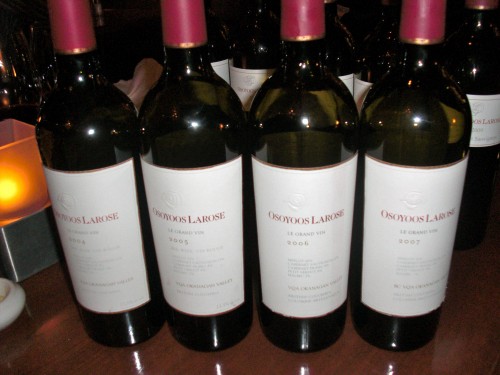
Vertical tasting of Osoyoos Larose (my notes):
Osoyoos Larose Le Grand Vin 2004 (91 points) — This is finally coming together and offers up a beautiful nose of black cherry, mocha, blackberry and kirsch. The tannins are softening but still evident on the palate and work nicely with the savoury fruit and rich spices.
Osoyoos Larose Le Grand Vin 2005 (87 points) — A fine nose of currants, cassis, earth, cherry and spice. It’s vibrant but disjointed on the palate. Not quite in balance and it may never get there, but it still shows power and rich, juicy fruits.
Osoyoos Larose Le Grand Vin 2006 (88 points, $45 at Vintages) — One to buy and lay down for a few years. Plums, blackberry and rich cherry fruits to go with roasted coffee bean and smoky spices on the nose. It’s tight on the palate, tannins definitely in charge at the moment, but has the fruit to bring it into harmony down the road. A savoury treat with raspberry, leather, spice and smoke built for lovers of big red wines. Cellar five to 10 years or more.
Osoyoos Larose Le Grand Vin 2007 (92 points, 800 cases of six bottles available April 30 at Vintages) — Madevon has hit the mark with this vintage. I can finally see where he’s headed for his Bordeaux-style blend. The extraction levels have been toned down leaving wonderful purity of cherry-blackberry-wildberry fruits mingling with savoury spice and oak tones. The tannins are not dominant on the palate with the array of layered fruit coming forward and harmonizing with mocha-licorice spice. Lovely length on the finish. Best Osoyoos yet.
Winemaker’s notes on the vintages above:
Le Grand Vin 2007
The 2007 Le Grand Vin is a dark, deep-coloured, full-bodied blend of Merlot, Cabernet Sauvignon, Cabernet Franc, Malbec and Petit Verdot. This vintage displays aromas and flavours of vanilla, raspberry, plums, chocolate, as well as spices including pepper and mint. The wine is very complex with a succession of different, elegant layers. The tannins are velvety and smooth, with a long, lingering finish. To express its quality, the 2007 Le Grand Vin is best when decanted for one or two hours before serving. Osoyoos Larose 2007 Le Grand Vin can be aged for 10 to 20 years. It is best served with duck breast, grilled lamb, filet mignon or with semi-hard dry grain cheeses.
Le Grand Vin 2006
The 2006 Le Grand Vin was created by combining classic Bordeaux varietals: Merlot (69%), Cabernet Sauvignon (20%), Cabernet Franc (4%), Petit Verdot (4%), and Malbec (3%). The wine was aged 16 months in a 60/40 split of new and one-year-old French oak barrels in addition to six months of bottle-aging prior to release; 120,000 bottles of the 2006 vintage were produced. The wine is extremely flavour-full with red fruit, a big nose, big body, lots of tannin, smooth and full. The alcohol was 13.8% residual sugar 4.5 g/l, the pH level 3.99 and the tartaric acid 5.7 g/l.
Le Grand Vin 2005
The 2005 vintage is a blend of the five classic Bordeaux varietals: Merlot (67%), Cabernet Sauvignon (23%) Cabernet Franc (4%), Petit Verdot (4%), and Malbec (2%). The wine was aged 16 months in a 60/40 split of new and one-year-old French oak barrels in addition to six months of bottle-aging prior to release. In the characteristic Bordeaux style, the 2005 vintage has concentrated colour, aromas of rich vanilla, coffee bean, and ripe red berry aromas and flavours. The wine displays powerful, velvety tannins, excellent balance and a long lingering finish; 125,700 bottles of the 2005 vintage were produced. The alcohol was 13.8%, residual sugar 1.4 g/l, the pH level 3.83 and the tartaric acid 6.5 g/l.
Le Grand Vin 2004
The 2004 vintage is a blend of the five classic Bordeaux varietals: Merlot (68%), Cabernet Sauvignon (21%), Malbec (2%), Petit Verdot (5%) and Cabernet Franc (4%). The wine was aged 18 months in a 60/40 split of new and one-year-old French oak barrels in addition to four months of bottle-aging prior to release. A classic Bordeaux style, the 2004 vintage has very deep colour, rich vanilla and ripe red berry aromas and flavours. The wine displays big velvety tannins, excellent balance and a long lingering finish; 111,000 bottles of the 2004 vintage were produced The alcohol was 13.5%, residual sugar 3.2 g/l, pH level 3.90, total acidity 6.2 g/l tartaric acid.
Enjoy!


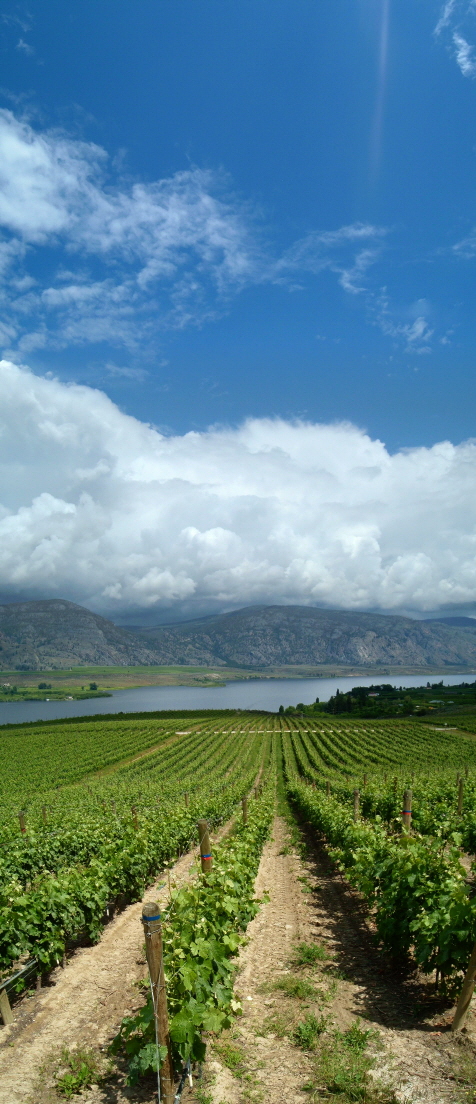





Comment here